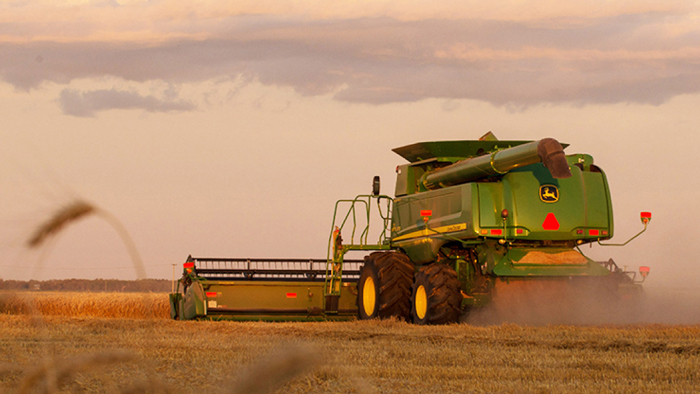Unearthing the Latest on Harvest Equipment

By Geoff Geddes
The saying “don’t bring a knife to a gunfight” may seem painfully obvious, unless you’re the guy with the knife; then it’s just painful. Apart from saying “no” to duels, the key lesson for soy farmers at harvest is that you’re only as good as your equipment, so it pays to think about what you use, how you use it, and whether it’s the best way to achieve your harvesting goals.
Watch your headers
Just as success in battle relies on using your head, getting optimal results at harvest begins and ends with your header.
“It’s important to have a reliable, well performing header to ensure a producer can maximize harvest time by being able to harvest longer, handle a multitude of ever-changing conditions and optimize the yield through excellent crop recovery,” said Jason Strobbe, North American sales manager for MacDon Industries Ltd. based in Winnipeg.
In terms of crop recovery, Strobbe said the header is even more important than the combine, as “most combines do a good job of threshing soybeans, but getting them from the field to the combine in the first place is a challenge.”
Low and easy
Using the proper equipment properly is important in all areas of farming, yet it may be even more so when dealing with soybeans.
“Soybeans are a fragile plant with low seed height which makes them prone to shelling at harvest. It is therefore critical that harvest equipment can cut close to the ground in order to capture all the low hanging pods and maximize yield,” said Michael Flintoft, product manager for MacDon.
Additionally, he said the machine must be gentle when handling the cut crop to prevent excessive damage and adapt to changing field conditions, such as wet/dry or flat/rolling land.
The notion of soybeans needing special attention is supported by Wes Hildebrand, a field adviser with Enns Brothers covering southeast Manitoba.
“Soybeans can be especially finicky,” said Hildebrand. “Having rolled fields and no rocks is crucial, and without the proper equipment, you’ll leave a lot of crop in the field.”
Flex some farming muscle
While there aren’t a lot of new developments in harvest equipment this year, one innovation that’s relatively new is the flex header.
“By following the contours of the earth, a flex header leaves less behind, so it can make a real impact,” said Hildebrand.
For his part, Jason Strobbe is quite excited about the MacDon FlexDraper and its ability to maximize crop control while limiting shatter loss.
“It provides a multi-crop solution by conveying crop with a gentle draper instead of an auger,” said Strobbe. “The unique three section frame and two section reel uses a balance linkage design with a quick reacting mechanical float to follow ground undulations and maintain the best reel to cutterbar relationship in the industry.”
According to Hildebrand, John Deere’s flex draper header is also a standout option.
“It’s a true flex header in that it flexes from one end to the other. Some flex headers only flex in 3 places so you can be left with beans still in the field.”
Practices make perfect
Just as farming equipment is evolving, farming practices are following suit.
“We are starting to witness different planting alternatives such as solid seeding and planters with row spacing configurations such as 15 inch, 20 inch, 22 inch, and 30 inch,” said Strobbe.
Like the guy who left his gun at home, sometimes success is more about what not to do.
“If you don’t have your header set properly, it will float too much or have the wrong angle so you end up digging in the dirt,” said Hildebrand. “The right header and the right set up are very important.”
For those currently pricing out the latest harvest equipment, taking a big picture view can pay off in the end.
“Some people will think short-term cost over long-term value and purchase a less expensive, poorer performing harvesting solution,” said Strobbe. “We always hear from producers that they should have bought a draper header, not only for their beans but for the rest of their harvesting needs.”
Strobbe’s colleague Michael Flintoft put it this way: “Often the extra money spent on the initial purchase price will be paid back many times through crop saved and equipment resale value down the road.”
To Hildebrand, choosing the right harvest equipment is part of an overall strategy he advocates.
“Regardless of where and what you’re planting, we urge you to get started properly in the springtime and set yourself up for success. If you start right, you’ll finish right, as long as Mother Nature agrees.”
And if you still think that the right equipment isn’t vital to success, remember, that’s what the knife guy thought.


